T0@st
News Editor
- Joined
- Mar 7, 2023
- Messages
- 3,051 (3.88/day)
- Location
- South East, UK
| System Name | The TPU Typewriter |
|---|---|
| Processor | AMD Ryzen 5 5600 (non-X) |
| Motherboard | GIGABYTE B550M DS3H Micro ATX |
| Cooling | DeepCool AS500 |
| Memory | Kingston Fury Renegade RGB 32 GB (2 x 16 GB) DDR4-3600 CL16 |
| Video Card(s) | PowerColor Radeon RX 7800 XT 16 GB Hellhound OC |
| Storage | Samsung 980 Pro 1 TB M.2-2280 PCIe 4.0 X4 NVME SSD |
| Display(s) | Lenovo Legion Y27q-20 27" QHD IPS monitor |
| Case | GameMax Spark M-ATX (re-badged Jonsbo D30) |
| Audio Device(s) | FiiO K7 Desktop DAC/Amp + Philips Fidelio X3 headphones, or ARTTI T10 Planar IEMs |
| Power Supply | ADATA XPG CORE Reactor 650 W 80+ Gold ATX |
| Mouse | Roccat Kone Pro Air |
| Keyboard | Cooler Master MasterKeys Pro L |
| Software | Windows 10 64-bit Home Edition |
The Moore Threads MTT S80 gaming-oriented graphics card has been tested mostly by Chinese hardware publications, but Japan's PC Watch has managed to get hold of a sample unit configured with 16 GB GDDR6 (14 Gbps) for evaluation purposes and soon published their findings in a "HotHot REVIEW!" The MTT S80 GPU appears to be based on PowerVR architecture (developed by Imagination Technologies), but official Moore Threads literature boasts that their own Chunxaio design is behind all proceedings with 4096 "MUSA" cores. The GPU's clock speed is set at 1.8 GHz, and maximum compute performance has been measured at 14.2 TFLOPS. A 256-bit memory bus grants a bandwidth transfer rate of 448 GB/s. PC Watch notes that the card's support for PCIe Gen 5 x 16 (offering up to 128 GB/s bandwidth) is quite surprising, given the early nature of this connection standard.
Moore Threads has claimed in the past that their cards support Direct X, but PC Watch has discovered that the S80 does not work with DX12, and their tests also demonstrated significant compatibility issues under DX11—with plenty of system freezes and error messages logged. The reviewer(s) had to downshift in some cases to DX9 game environments, in order to gather reliable/stable data. TPU's GPU-Z utility is shown to have no registration information for the S80, and it cannot read the GPU's clock. PC Watch compared their sample unit to an NVIDIA GeForce GTX 1050 Ti graphics card—the entry level 2016-era GPU managed to best the newer competition in terms of in-game performance and power efficiency.
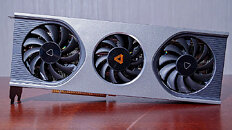
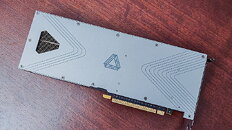
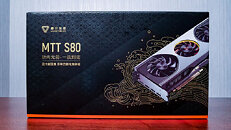

The triple-fan cooled MTT S80 has a 255 W TGP rating, and PC Watch measured an average power consumption of 142 W which seems ludicrous when placed next to the 1050 Ti only consuming 60 W (on average). The much older (75 W TGP) card has 4 GB DDR5 VRAM with a 112 GB/s bandwidth—its meagre compute performance (2.1 TFLOPS) should be far outpaced by the MTT S80 GPU, but the latter's full potential is almost certainly dragged down by unoptimized drivers. Tom's Hardware has translated some of PC Watch's charts:
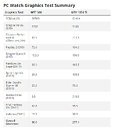
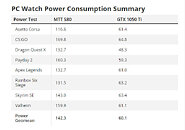
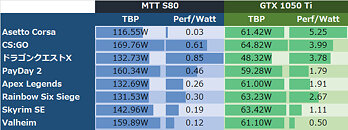
A video segment was included with PC Watch Japan's published review of the Moore Threads MTT S80 graphics card:
View at TechPowerUp Main Site | Source
Moore Threads has claimed in the past that their cards support Direct X, but PC Watch has discovered that the S80 does not work with DX12, and their tests also demonstrated significant compatibility issues under DX11—with plenty of system freezes and error messages logged. The reviewer(s) had to downshift in some cases to DX9 game environments, in order to gather reliable/stable data. TPU's GPU-Z utility is shown to have no registration information for the S80, and it cannot read the GPU's clock. PC Watch compared their sample unit to an NVIDIA GeForce GTX 1050 Ti graphics card—the entry level 2016-era GPU managed to best the newer competition in terms of in-game performance and power efficiency.




The triple-fan cooled MTT S80 has a 255 W TGP rating, and PC Watch measured an average power consumption of 142 W which seems ludicrous when placed next to the 1050 Ti only consuming 60 W (on average). The much older (75 W TGP) card has 4 GB DDR5 VRAM with a 112 GB/s bandwidth—its meagre compute performance (2.1 TFLOPS) should be far outpaced by the MTT S80 GPU, but the latter's full potential is almost certainly dragged down by unoptimized drivers. Tom's Hardware has translated some of PC Watch's charts:



A video segment was included with PC Watch Japan's published review of the Moore Threads MTT S80 graphics card:
View at TechPowerUp Main Site | Source



